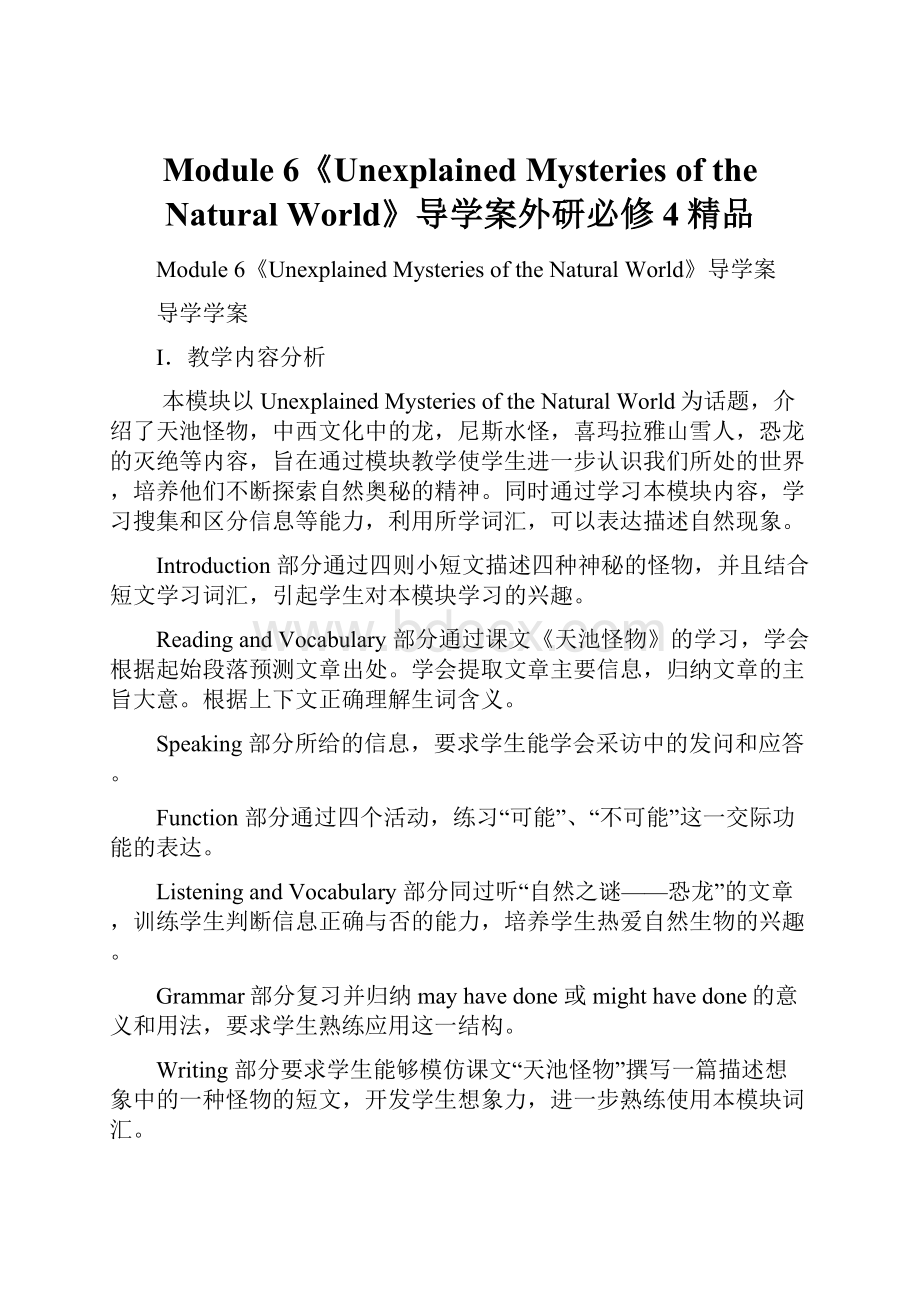Module 6《Unexplained Mysteries of the Natural World》导学案外研必修4精品.docx
《Module 6《Unexplained Mysteries of the Natural World》导学案外研必修4精品.docx》由会员分享,可在线阅读,更多相关《Module 6《Unexplained Mysteries of the Natural World》导学案外研必修4精品.docx(26页珍藏版)》请在冰豆网上搜索。

Module6《UnexplainedMysteriesoftheNaturalWorld》导学案外研必修4精品
Module6《UnexplainedMysteriesoftheNaturalWorld》导学案
导学学案
I.教学内容分析
本模块以UnexplainedMysteriesoftheNaturalWorld为话题,介绍了天池怪物,中西文化中的龙,尼斯水怪,喜玛拉雅山雪人,恐龙的灭绝等内容,旨在通过模块教学使学生进一步认识我们所处的世界,培养他们不断探索自然奥秘的精神。
同时通过学习本模块内容,学习搜集和区分信息等能力,利用所学词汇,可以表达描述自然现象。
Introduction部分通过四则小短文描述四种神秘的怪物,并且结合短文学习词汇,引起学生对本模块学习的兴趣。
ReadingandVocabulary部分通过课文《天池怪物》的学习,学会根据起始段落预测文章出处。
学会提取文章主要信息,归纳文章的主旨大意。
根据上下文正确理解生词含义。
Speaking部分所给的信息,要求学生能学会采访中的发问和应答。
Function部分通过四个活动,练习“可能”、“不可能”这一交际功能的表达。
ListeningandVocabulary部分同过听“自然之谜——恐龙”的文章,训练学生判断信息正确与否的能力,培养学生热爱自然生物的兴趣。
Grammar部分复习并归纳mayhavedone或mighthavedone的意义和用法,要求学生熟练应用这一结构。
Writing部分要求学生能够模仿课文“天池怪物”撰写一篇描述想象中的一种怪物的短文,开发学生想象力,进一步熟练使用本模块词汇。
Pronunciation部分通过听力的训练,让学生掌握语音中的失去爆破现象。
EverydayEnglish部分主要通过选择题的形式使学生掌握backinthenews,throwlightonsomething等几个日常英语的运用。
CulturalCorner部分是一篇学生很感兴趣的文章,介绍了龙在不同文化中的象征及其缘由,通过阅读了解外国文化,拓展学生的文化背景知识,提高学生文化底蕴和对外国文化的感悟能力。
并让学生对比中外文化,发现两者之间的差异。
Task部分是结合本模块学习内容,要求学生小组活动,讨论某种大自然的神秘生物或神秘现象,然后以向游客介绍的方式进行描写,训练学生描写自然的能力。
ModuleFile部分有助于学生对本模块学习内容进行归纳,对自己的学习进行总结和检验。
II.教学重点和难点
1.教学重点
(1)掌握一些和自然及动植物有关的词汇。
(2)学习情态动词表猜测的用法。
(3)学习提取文章有用信息,猜测词义的方法。
2.教学难点
(1)听懂描述陌生事物并能做出正误判断,正确理解新学词汇的含义。
(2)正确使用情态动词来表示猜测,特别是对过去的猜测。
(3)学会利用已知词汇来描写介绍自然现象,动植物生活等自己感兴趣的话题。
III.教学计划
本单元分五个课时:
第一课时:
Introduction,Speaking,
第二课时:
ReadingandVocabulary,Writing
第三课时:
VocabularyandListening,Pronunciation,EverydayEnglish
第四课时:
Grammar,Function
第五课时:
CulturalCorner,task,ModuleFile
IV.教学步骤:
Period1Introduction,Speaking
TeachingGoals:
1.ToarouseSs’interestinlearningaboutmysteriousthings.
2.TogetSstolearnsomewordstodescribemysteriesofthenature.
3.TogetSstoknowanddescribesomemysteriousthingsinnature.
TeachingProcedures:
Step1.Introduction
Purpose:
ToarouseSs’interestinlearningaboutmysteriesofthenature.
1.Pairwork
(1)AskSstolookatthefourpicturesonpage51andgivesomedescriptionsintheirownwords.
Foryourreference:
①Alargefootwhichlookslikeagiant's.Itissimilartoourhumanbeing’sbutmuchbiggerthanit.Strangelyithasonlyfourtoes.
②Ahugemonsterlikeagorilla,butlookstallerandstrongerthanagorilla.YoumayfindthesamecreatureinthefilmKingKong.
③AkindofanimallikeahugedragoninancientChineselegend.Itlivesinthewater.
④Aterriblecreaturewithlonggreyhairandface.Ithaslongclawsinsteadofhands.
(2)LetSsreadthefourparagraphsandmatchthemwiththepictures.
SuggestedAnswers:
①b②a③d④c
2.Individualwork
AskSstodoActivity2onpage51individually.
SuggestedAnswers:
(1)creature
(2)monster(3)hairy(4)footprint(5)tail
(6)dinosaur(7)spirit(8)claw(9)attack
Step2.Speaking
Purpose:
ToenableSstopracticereportingmysteriesofthenature.
1.Pairwork
AskSstosupposetheyareinterviewedbyajournalisttodescribesomethingaboutthemonsterstheysaw.Askthemtodotherole-playinpairs.Oneactstheinterviewerandtheotheractstheinterviewee.
AskthemtodescribethefourcreaturesinActivity1ofIntroductiononebyoneaccordingtheinformationshowedintheintroduction.ShowSstwoexamplestoguidethem.
Example
(1):
StudentA:
WhereandwhenyousawtheBigfoot?
StudentB:
Iwascuttingthefirewoodinthemountainousforeststhatevening.About6o'clock,whenIwantedtogohome,itappearedinthewoods20yardsfromme.
StudentA:
Whatisitlike?
StudentB:
Itlookslikeaverylargemonkey—tallandhairywithbigarmsandlegs.
StudentA:
Didyoufeelfrightenedthen?
StudentB:
Yes,very.Ithoughtitwouldattackme.Iwasfrightenedtodeath.
…
Example
(2)
StudentA:
CanyoudescribethescenewhenyoumetthemonsterlikeTheYeti?
StudentB:
yeah.It’sabouttwometerstallandhaspowerfularmsandlegs.Itsheadisverybiganditseyesopenedwide.Itapproachedmeslowlyasifitwantedtoattackme.IwasveryfrightenedbutIdidn’tdaretocryforhelp…
StudentA:
It’sreallyexcitingandrisky.Butwhathappenedlast?
StudentB:
….
2.Individualwork
AskSstosaytheimaginarycreaturesandsceneindetailsaccordingthedialoguetheymade.Thenreportinindividuals.
Step3.Homework
1.AskSstorevisethepassagesintheIntroduction.
2.AskSstopractisemakingdialoguetosaythemonsters.
3.AskSstopreviewReadingandVocabularyinthemodule.
Period2ReadingandVocabulary,Writing
TeachingGoals:
1.ToletSsmasterhowtogetusefulinformationfromapassage.
2.ToletSsmastersomewordsandphrases.
3.TogetSstotalksomethingaboutamonster.
4.TohelpSswriteastoryaboutanothermonster.
Teachingprocedures:
Step1.Revision:
Purpose:
TocheckwhetherSsmasterwhatthey’velearntinthelastperiodornot.
AskSstoanswerthefollowingquestions.
(1)WhatwilltheYetidowhenitgetsangry?
(2)WhatdoestheBigfootlooklike?
(3)WheredoestheGreymanlive?
(4)What'stheLochNessMonsterlike?
SuggestedAnswers:
(1)Itwillattackanyonewhogoesclosetoit.
(2)Itlookslikeaverylargemonkey–tallandhairywithbigarmsandlegs.
(3)TheGreymanlivesonmountainsinScotland.
(4)Ithasasmallheadandalongtailandsomepeoplebelieveitisadinosaur.
Step2.Leading-in
Purpose:
ToletSshaveadiscussionabouttheMonsterofLakeTianchi.
1.Groupwork
ShowfourpicturesandaskSstosaysomethingabouttheLakeTianchiandthemonster.
2.Groupwork
LetSsreportedtheirdiscussionstotheclassandcollectthem.Thengiveasimpleintroductiontoleadinthereading.
Foryourreference:
LakeTianchiislocatedinthenorth-easternJilinprovinceneartheborderofNorthKorea,inChina.Thelakeis1,243feetdeepandhashadsomevolcanicactivityinthelast300years.TianchiishonoredasthedeepestmountainlakeandthelargestcraterlakeinChina.
Therehavebeenmorethan30reportedsightingsbytouristsfromhomeandabroadoverthepast20years.Theysaidthattheysawthegreatmonsterinthelake.Therearequiteafewpicturesandvideosofthiscreature,butnoneisclearenoughtogiveagoodappearanceofit.Somepersonsmadethepicturewithcomputerimagesofitbasedoninterviews.Someonedrewapicturetoshowitsshape,butitremainsunconfirmed.
Step3.Reading
Purpose:
ToimproveSs’readingskills.
1.Skimming
AskSstoreadthebeginningofthepassageandfinishActivity1onpage52.
SuggestedAnswers:
Anewspaper.
2.Scanning
(1)AskSstoreadthefirstparagraphquicklyandanswerthetwoquestions.
①Accordingtothetext,whatdidthemonsterlooklike?
②Howmanypeoplesawit?
SuggestedAnswers:
1Blackincolor;jumpedlikeaseal;itsheadlookedlikeahorse.
②About200
(2)AskSstoreadthesecondparagraphandanswerthequestions:
①Whoelsesawtheanimal?
②Whatweretheydoing?
③Whatdiditlooklike?
SuggestedAnswers:
①Agroupofsoldiers
②Theywerewalkingalongthesideofthelake.
③Itwasgreenish-blackandhadaroundheadwith10cmhorns.
(3)AskSstoreadthethirdandfourthparagraphandanswerthequestions.
①WhatdidLiXiaohesee?
②Whycouldtheyseetheanimalclearly?
③HowlongwasthehistoryofreportsofmonstersinLakeTianchi?
④Whatdomanypeoplethink?
⑤Whatdothescientiststhink?
SuggestedAnswers:
①Aroundblackcreaturemovingquicklythroughthewater.After300or400metersitdivedintothewater.
②Theweatherwasfineandthelakewascalm.
③Sincethebeginningofthelastcentury.
④ThemonstermaybeadistantcousinoftheLochNessmonsterinScotlandandtheremightbesimilarcreaturesinotherlakesaroundtheworld.
⑤Thelow-temperaturelakeisunlikelytobeabletosupportsuchlargelivingcreatures.
(4)AskSstoreadthelastparagraphandgivethefollowinginformationaboutLakeTianchi:
Height:
①Area:
②Depth:
③
SuggestedAnswers:
①2189m②10km2③370mdeepinsomeplaces
4.Post-reading
AskSstodoActivity4onpage53.Thenchecktheiranswers.
SuggestedAnswers:
(1)a
(2)a(3)a(4)b(5)c(6)a(7)a(8)c(9)c(10)b
Step4.LanguagePoints
Purpose:
ToletSsunderstandthepassagewell.
1.Groupwork
2.AskSstodiscusstheimportantanddifficultlanguagepointsingroups.
(1)Itoftengetsangryandwillattackanyonewhogoesclosetoit.(Page51)
它经常生气,会袭击靠近它的任何人.
attackvt&vi袭击
E.g.①Agirlwasattackedandrobbedbytwostrongmen.
②Theenemyattackedduringthenight.
※【拓展】
◆attackvt抨击
attacksb/sthforsth为某事抨击某人
E.g.Hewasattackedforhiscorruption.
◆attackn
launch/makeanattack(onsb/sth)攻击某人或者某物
E.g.Theylaunchedanattackonracism.
(2)Heclaimstohaveseenaroundblackcreaturemovingquicklythroughthewater.(Page52)
他说他看见一个圆形黑色的东西在湖面快速游过。
claimvt宣称,声称(后可跟that从句或动词不定式)
E.g.①Idon’tclaimtobeanexpert.
②Heclaimedheshouldbegivenafaireropportunity.
※【拓展】
claim的意思还有:
◆vt要求,认领
E.g.Hasanyoneclaimedthiswatch?
◆vt索赔,索取
E.g.Didyouclaimtheinsuranceafteryourcaraccident?
◆vt注意,思考
E.g.Thematterclaimsourattention.
(3)Itis2,189metreshighandcoversanareaofabouttensquarekilometers.(Page52)
天池海拔2189米,面积有10平方公里
coveranareaof意为“占有……空间”,也可以只用cover表示此意。
E.g.Thetowncovers(anareaof)5squaremiles.
※【拓展】
cover的其他意思还有:
◆vt覆盖
E.g.Themountainiscoveredwithsnowalltheyearround.
◆vt包含,涉及
E.g.Thelecturecoversmanyaspectsofbusiness.
◆vt走完(一段路程)
E.g.Icancoverthedistanceonfootintwohours.
◆vt报道
E.g.Thereportersarecoveringthefireforanewspaper.
(4)Theysaythatthelow-temperaturelakeisunlikelytobeabletosupportsuchlargelivingcreatures.(Page52)他们说,温度低的湖中不可能存活如此大的生物。
◆be(un)likelytodo…(不)可